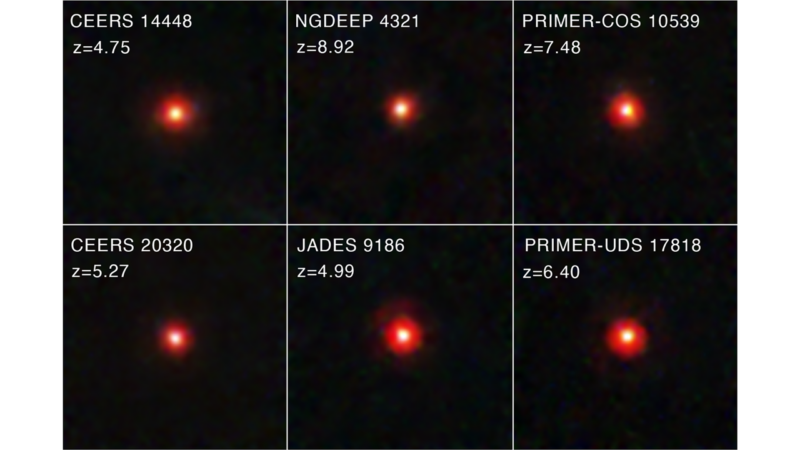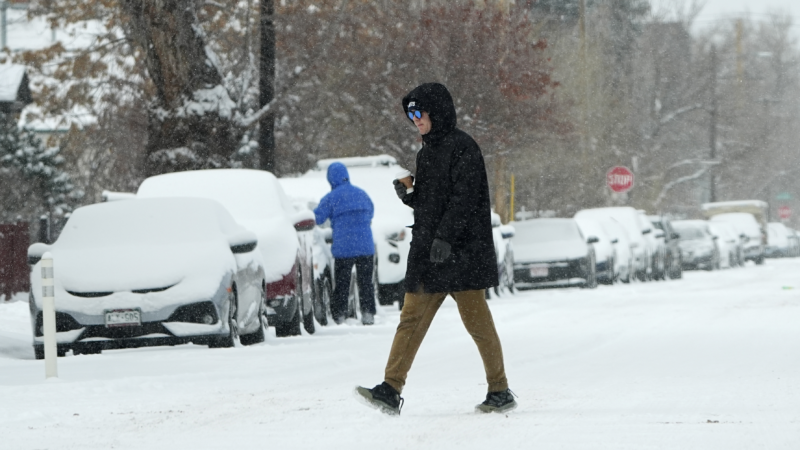James Webb Space Telescope’s ‘little red dots’ come into focus
Of all the mysteries that the massive James Webb Space Telescope has seen so far in the early universe, one of the strangest are objects that astronomers now call “little red dots.”
Like the nickname suggests, these celestial objects appear to be compact—much smaller than our Milky Way galaxy. And their color is reddish, although their light signatures are also unusual in ways that astronomers have struggled to explain.
Now, at a conference of the American Astronomical Society being held this week in Maryland, astronomers say they combed through public data from the James Webb Space Telescope (JWST) to collect hundreds of examples of little red dots.
Their study shows that these cosmic oddballs appear to be a common but transient feature of the early universe.
“Essentially, all of them exist back when the universe was a billion years old or younger, and then they petered out,” says Dale Kocevski, an astrophysicist at Colby College.
They may only seem to go away because their appearance changes, he says, and “it could be that we’re seeing the formation of the core of today’s massive galaxies.”
Large galaxies that exist today almost all seem to have a supermassive black hole at their centers, he notes. A subsample of little red dots that researchers examined in more detail showed light signatures that indicate hot gasses spiraling down into a growing black hole.
That could mean the little red dots are, “a potential building block, or maybe the first stage, of producing the galaxies and black holes that we see today,” says Kocevski.
Breaking the universe
The enormous $10 billion JWST is about a million miles away from Earth, and it’s able to detect extremely faint objects that the Hubble Space Telescope and ground-based telescopes never saw.
When the little red dots first showed up in some of JWST’s early observations, in December of 2022, it was a surprise.
These faint objects are so far away that the light has to travel for billions of years before it’s finally detected by the telescope, which means the light reveals how the universe appeared in its early stages of development.
The bright little red dots initially looked to be massive galaxies putting out dust-reddened starlight, but no one could understand how Milky Way-sized galaxies could have built up that fast, so soon after the Big Bang.
People started talking “about how JWST was breaking the existing theories of universe formation,” says Kocevski, “because these things were too massive too early on in the history of the universe.”
In early 2023, however, he and some colleagues examined a little red dot and detected light signatures indicative of gas rapidly spinning down into a black hole.
So, they wondered if it could be that the light from little red dots could be coming from both a growing black hole and the stars in a small host galaxy, rather than stars alone.
“They may not be these massive galaxies,” says Kocevski.
He and his colleagues wanted to see if other little red dots had signs of a black hole lurking within, so they searched through public data, hunting for as many objects with the specific features of little red dots that they could find.
Looking at 341 of them revealed that these objects mostly appeared around 600 million years after the big bang and then declined, disappearing by about 1.5 billion years ago.
Hotly debated
A subset of a couple dozen little red dots had additional data available, 80% of them showed those same signs of gas spiraling into a black hole, Kocevski says.
“So it does look like there’s a good chance that these are actively accreting supermassive black holes,” he says. “The thing that’s surprising is, they’re just really, really common. They’re much more common than we would have anticipated.”
Still, some astronomers continue to believe that little red dots are, in fact, massive galaxies, he says.
Little red dots aren’t bright in X-ray light, which would normally be seen from black holes. It may be, however, that gases are obscuring this form of light.
“It’s been a very, very healthy academic debate as to what’s going on with these things,” he says. “It’s exciting because rarely do you find a population of objects where you say, ‘I simply don’t know what’s going on here.’ “
Heavy snow and frigid temps put 70 million in the U.S. under winter storm warnings
Residents along the East Coast, from the Northern Plains to the tip of Maine, are bracing for several inches of snow on Sunday followed by dangerously cold temperatures.
TikTok is back online in the U.S., following Trump’s promise to pause the ban
The president-elect said he will issue an executive order Monday to delay the ban while he brokers a sale. The app has returned on web and mobile, but is not available in Apple and Google's stores.
Biden pardons Virginia House Speaker Don Scott, Black nationalist Marcus Garvey
President Joe Biden pardons five people and commutes the sentence of two others who "made significant contributions to improving their communities."
Why Trump’s tariff promises will be hard to keep
President-elect Donald Trump has said his tariffs will raise revenues, boost U.S. jobs, and help stop the drug trade. But some of these goals are at odds with the others.
Ceasefire goes into effect in Gaza, Israel says, after initial delay
The Israeli government announced the ceasefire with Hamas would take effect at 11:15 local time, nearly three hours after the originally scheduled time for hostilities to cease.
Many doctors don’t discuss sex after cancer. But survivors wish they would
Questions about sex and intimacy often go unanswered for people with cancer. It's a glaring problem, especially for the growing number of young people being diagnosed.





